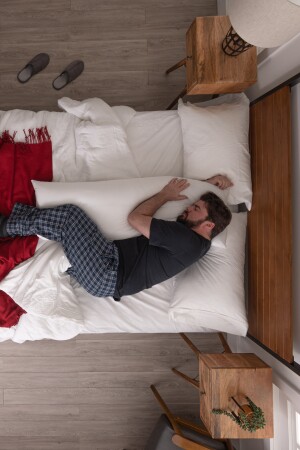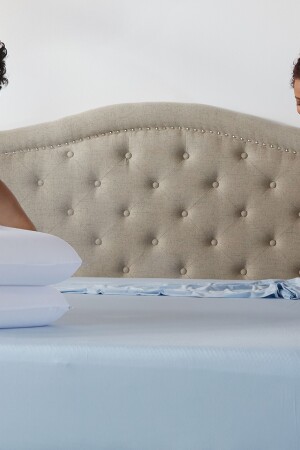Perhaps one of the most common—albeit vague—pieces of advice you’ll often hear when you’re in the market for a new mattress is to find one with “good support.” But what does that even mean? And is mattress support the same as mattress firmness? If you’ve ever wondered what good mattress support actually implies and what the right support can do for your sleep, you’ve come to the right place.
“Proper support is paramount to a deep and restorative night’s sleep,” says David Cartlidge, senior director of product innovation at Mattress Firm. “While you’re awake, your muscles do the work of supporting your skeletal frame, keeping your spine and neck in alignment. For you to achieve deep or REM sleep, your muscles must completely relax, leaving your mattress to do the critical work of supporting your skeleton. Without the proper support, your muscles have to remain engaged and often working overtime to keep your spine and neck in alignment, which is a key driver of aches and pains upon waking.”
To learn about the best support for you and figure out what good support means, read on to learn what the Sleep Experts® say.
What Is “Good” Mattress Support?
Unlike the firmness of a mattress (how hard or soft it feels) or its comfort (how much you sink into the top of it), the support of a mattress refers to its ability to stabilize your resting body and evenly distribute your weight.
“I would define it as supporting the various contours of the body in a way that distributes pressure evenly and not creating pressure points,” says Dr. Chris Winter, neurologist, Mattress Firm advisor and author of “The Rested Child” and “The Sleep Solution.” “Firmness is a general sense of the compressibility or give of the mattress material,” Winter says. “Support is how well that material distributes the weight and pressure of the sleeper.”
If you’ve ever developed chronic back pain after switching to a new mattress, there’s a chance those aches were related to poor support. By resisting your body's weight and providing proper pressure to keep your spine correctly aligned, a supportive mattress can help you sleep more comfortably and stave off those aches and pains. While some people use the terms “comfort,” “support” and “firmness” interchangeably, support is a distinct feature that primarily has to do with the spine.
Is a Firmer Mattress More Supportive than a Plush Mattress?
While it’s understandable why people might assume a rock-hard mattress would ensure great support, that’s not always the case. While firmness refers to how hard or soft a mattress feels, support refers to whether the mattress encourages your spine to align correctly while you rest. This feature isn’t just a side effect of how hard the mattress is; it’s a reflection of the core materials of the mattress.
Here’s where it’s important to understand the anatomy of most mattresses. You now know the comfort of a mattress is related the layers on top of the support core. The point of the comfort system is to use materials like memory foam, fiber, polyfoam and more to cushion common pressure points like the hips and shoulders. When these layers are thicker, the mattress tends to feel softer; thinner layers lend themselves to a firmer feel.
The support core is located beneath those comfort layers. Its job is to prevent you from sinking too far into the mattress, and it keeps your spine as neutrally positioned as possible. Some support cores are also designed with special zones that offer extra structure in areas that typically bear more body weight. This means that you can actually have a mattress that is firm and unsupportive or soft and supportive, depending on its materials, design and layers.
Think about the basic support of a mattress as being like the floor. A firm mattress is somewhat like lying on the bare floor. The more blankets you add to cushion yourself from the floor, the more comfortable you will be. The same is true of a plush mattress—you still have the floor for support, but additional layers provide added comfort.
What Are the Different Types of Mattress Support Cores?
Generally speaking, there are several categories of support core mattress materials, including coils, polyfoam (or polyurethane foam), hybrid, air and water. Most mattresses have support cores built on coils, polyfoam or latex, but each type of material has its pros and cons, and each person’s support preferences are unique.
Innerspring Support System
Also known as coils, the innerspring system is designed to flex under pressure and spring back to its original shape when that pressure is removed, offering durability with a bouncy feel. This is the core support system most commonly found in innerspring and hybrid mattresses. Mattresses with a coil core have excellent temperature regulation but don’t offer much contouring.
Foam
Foam or polyfoam is available in a variety of densities, so it can form a soft, responsive core or a sturdy, durable one, though the inner support core is usually firm. Memory foam is a type of polyfoam that can conform to your body shape and respond to your body’s heat and pressure, providing a cradling sensation. Polyfoam core mattresses are widely available and fairly inexpensive; however, the foam does tend to trap heat more often then other materials.
Adjustable Support System (Air)
For a cushioned feel, some mattresses use air pockets, known as air bladders, under each sleeper. Different models could use a single bladder or multiple smaller chambers. Air is also, of course, used in air mattresses. This kind of support can be customizable.
How Can I Make My Current Mattress More Supportive?
If you are not getting the support you need while you sleep but you’re not quite ready to give up on your current mattress, there may be a few things you can try to make it a little more supportive:
- Try a mattress topper: Mattress toppers can bolster the comfort or support of your mattress. Available in a range of different thicknesses, materials and firmnesses, a good topper might help you get more support.
- Add a bunkie board between the mattress and the frame: Bunkie boards are a flat piece of material that can be a great alternative to a box spring. If your mattress is sagging, this is a great way to prevent further dipping while offering more support.
- Switch out your base: Just as different cores provide different levels of support, so do bases.
- Change up your room temperature: Some mattresses (such as foam) soften in warmer temperatures. Try lowering your bedroom thermostat or airing out your bedroom.
How to Choose the Right Mattress Support For You
While there is no one-size-fits-all solution for finding the level of mattress support that is right for you, there are some important first steps to consider. Think through your sleep concerns, including snoring, pain or other considerations, and look into characteristics that can address your specific issue.
At the end of the day, “good” mattress support is the type of support that helps you get the sleep you need and wake up feeling great. The best way to find your ideal mattress is to consult with a Sleep Expert in-store or online and to try out different products for yourself so you can find the perfect fit.









